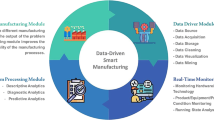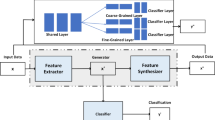Abstract
Deep neural network is an important computer operating system in China. It has made great breakthroughs in target recognition, image classification and other fields. It plays a key role in multi-system integration and intelligent manufacturing industry, such as training and testing. The purpose of this paper is to study the multi-system fusion of deep neural network and its application in intelligent manufacturing industry. By setting up experiments, the multi-system fusion of neural network is carried out, combining with big data and artificial intelligence to verify the efficient operation of neural network in multi-system fusion. Using the methods of mathematical analysis and big data fitting, the collected data are classified, the experimental data are collected and then analyzed. In this paper, the reliability of this method is verified by research; the application of multi-system fusion based on deep neural network in intelligent manufacturing industry can effectively integrate all systems, improve the comprehensive working efficiency of each system by about 20% and improve the multi-system fusion of deep neural network and its application in intelligent manufacturing industry by about 15%. Thus, as the terminal of the system, the deep neural network plays the leading role of multiple systems. It can effectively integrate the various systems and improve the comprehensive work efficiency of each system, which has guiding significance for the development of industry.






Similar content being viewed by others
References
Everingham M, Van CUI, Williams CKI (2015) The pascal visual object classes(voc) challenge. Int J Comput Vision 88(2):303–338
Mierzejewska L (2017) Sustainable development of a city: Systemic approach. Soc Sci Electron Publ 12(1):71–78
Ribic B, Voca N, Ilakovac B (2016) Concept of sustainable waste management in the City of Zagreb: Towards the implementation of circular economy approach. Air Repair 67(2):241–259
Muminovic M (2017) Place identity and sustainable urban regeneration: public space in Canberra City Centre. Int J Sustain Dev Plan 12(4):734–743
Han S, Liu X, Mao H et al (2016) EIE: efficient inference engine on compressed deep neural network. ACM SIGARCH Comput Arch News 44(3):243–254
Albericio J, Judd P, Hetherington T et al (2016) Cnvlutin: Ineffectual-neuron-free deep neural network computing. ACM SIGARCH Comput Arch News 44(3):1–13
Hmood AK, Suen CY, Lam L (2018) An enhanced histogram of oriented gradient descriptor for numismatic applications. Pattern Recogn Image Anal 28(4):569–587
Liu K, Skihhe H, Schmidt T et al (2016) Rotation-invariant HOG descriptors using Fourier analysis in polar and spherical coordinates. Int J Comput Vision 106(3):342–364
Bosse S, Maniry D, Müller KR et al (2017) Deep neural networks for no-reference and full-reference image quality assessment. IEEE Trans Image Process 27(1):206–219
Sirmacek B, Unsalan C (2019) Urban-area and building detection using SIFT keypoints and graph theory. IEEE Trans Geosci Remote Sens 47(4):1156–1167
Ren S, He K, Girshick R et al (2016) Object detection networks on convolutional feature maps. IEEE Trans Pattern Anal Mach Intell 39(7):1476–1481
Erichson NB, Brunton SL, Kutz JN (2019) Compressed dynamic mode decomposition for background modeling. J Real-Time Image Proc 16(5):1479–1492
Lin X, Rivenson Y, Yardimci NT et al (2018) All-optical machine learning using diffractive deep neural networks. Science 361(6406):1004–1008
Peng Y, He X, Zhao J (2017) Object-part attention model for fine-grained image classification. IEEE Trans Image Process 27(3):1487–1500
Quang D, Xie X (2016) DanQ: a hybrid convolutional and recurrent deep neural network for quantifying the function of DNA sequences. Nucleic Acids Res 44(11):e107–e107
Titano JJ, Badgeley M, Schefflein J et al (2018) Automated deep-neural-network surveillance of cranial images for acute neurologic events. Nat Med 24(9):1337–1341
Dong W, Wang P, Yin W et al (2018) Denoising prior driven deep neural network for image restoration. IEEE Trans Pattern Anal Mach Intell 41(10):2305–2318
Haroun B, Sheng LQ, Shi LH et al (2019) Vision based people tracking system. Int J Comput Inf Eng 13(11):582–586
Gao X, Duan LM (2017) Efficient representation of quantum many-body states with deep neural networks. Nat Commun 8(1):1–6
Costilla-Reyes O, Scully P, Ozanyan KB (2017) Deep neural networks for learning spatio-temporal features from tomography sensors. IEEE Trans Ind Electron 65(1):645–653
Ullah FUM, Ullah A, Muhammad K et al (2019) Violence detection using spatiotemporal features with 3D convolutional neural network. Sensors 19(11):2472
Kahng M, Andrews PY, Kalro A et al (2017) Activis: Visual exploration of industry-scale deep neural network models. IEEE Trans Visual Comput Gr 24(1):88–97
Henriques JF, Rui C, Martins P et al (2016) High-speed tracking with kernelized correlation filters. IEEE Trans Pattern Anal Mach Intell 37(3):583–596
Lindsey R, Daluiski A, Chopra S et al (2018) Deep neural network improves fracture detection by clinicians. Proc Natl Acad Sci 115(45):11591–11596
Luo X, Zhang J, Cao X (2016) Object aware power line detection using color and near-infrared images. IEEE Trans Aerosp Electron Syst 50(2):1374–1389
Liu H, Kou H, Yan C (2019) Link prediction in paper citation network to construct paper correlation graph. EURASIP J Wirel Commun Netw 2019(1):1–12
Gong W, Qi L, Xu Y (2018) Privacy-aware multidimensional mobile service quality prediction and recommendation in distributed fog environment. Wirel Commun Mobile Comput 2018(4):1–18
Piccialli F, Cuomo S, di Cola VS et al (2019) A machine learning approach for IoT cultural data. J Ambient Intell Human Comput 2019(2–3):1–12
Acknowledgements
This work is supported by Fund for Reserve Academic Leader 2020–2022 granted by Capital University of Economics and Business and Special Fund for Fundamental Scientific Research of the Beijing Colleges in CUEB granted by Capital University of Economics and Business.
Author information
Authors and Affiliations
Corresponding author
Ethics declarations
Conflict of interest
There are no potential competing interests in our paper. And all authors have seen the manuscript and approved to submit to your journal. We confirm that the content of the manuscript has not been published or submitted for publication elsewhere.
Additional information
Publisher's Note
Springer Nature remains neutral with regard to jurisdictional claims in published maps and institutional affiliations.
Rights and permissions
About this article
Cite this article
Fan, L., Zhang, L. Multi-system fusion based on deep neural network and cloud edge computing and its application in intelligent manufacturing. Neural Comput & Applic 34, 3411–3420 (2022). https://doi.org/10.1007/s00521-021-05735-y
Received:
Accepted:
Published:
Issue Date:
DOI: https://doi.org/10.1007/s00521-021-05735-y




